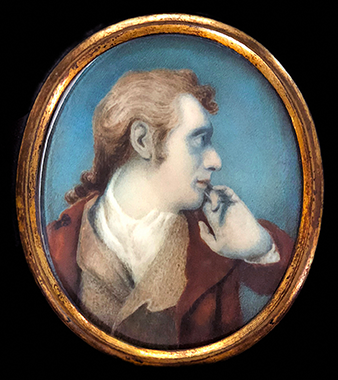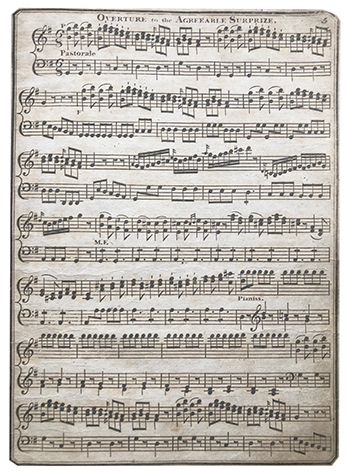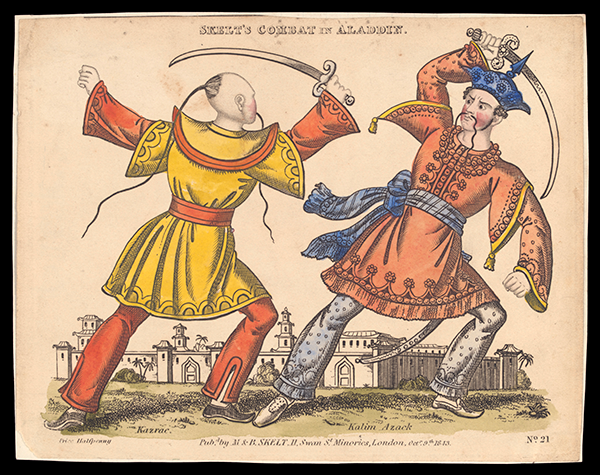ALADDIN AND THE BLIND IRISH PLAYWRIGHT JOHN O’KEEFFE (1747–1833)
Published in Features, Issue 3 (May/June 2022), Volume 30By Lynda A. O’Keeffe
Introducing John O’Keeffe, a man who in his own time needed no introduction at all—one of the most prolific and significant playwrights of the eighteenth century. With works including operas, comedic farces and poetry, he could be called the Andrew Lloyd Webber of Georgian theatre. A playwright of cosmopolitan London and Dublin, he was a crucial conduit for representing the positive qualities of Ireland and its culture to London’s theatrical audiences. Throughout, he was loyal to both shamrock and crown, a proud Irishman whose loyalty to King George III was also beyond reproach.
BACKGROUND

Above: Miniature of John O’Keeffe by his brother Daniel, painted in 1776, the year John lost his sight (NGI).
John O’Keeffe’s story is one of survival and success in the face of adversity. He was born in Abbey Street, Dublin, on 24 June 1747 into an affluent Catholic family, his father a native of the King’s County, his mother of County Wexford. Being born into a life of privilege ensured a fine education, and he became a Classics scholar proficient in four languages. Because of his parents’ wish for their sons to become artists, John and his brother Daniel were sent to Dublin’s Royal Academy of Art (RAA). John’s skill with a paintbrush led to numerous commissions in both portraiture and landscape, but little did he foresee that the observational skills he learnt at the RAA would in the future be his most treasured and invaluable tools.
In 1761 he visited London and upon seeing David Garrick perform was mightily impressed. For the fourteen-year-old O’Keeffe, this was to be the catalyst behind his life choices, as explained in his Recollections of the life of John O’Keeffe:
‘My fancy soon strayed to Shakespeare, Old Ben, Congreve, Cibber and Farquhar. The first edition of Farquhar’s comedies set me studying and acting private plays among my schoolfellows; and this transition from drawing to poetizing was ultimately (as my sight began to fail at seven and twenty) very fortunate for me—a man can compose with his pen in the hand of his amanuensis [literary assistant]; but the pencil he must hold in his own hand.’
He went on to study at Trinity College, Dublin, at a time when it was seen as the university of Protestant Ascendancy. There were numerous well-known covert Catholics attending, however, and O’Keeffe was one of them. A bright young man with a character described as forever merry and good-hearted, he was the life and soul of the party, with a fine singing voice, a quick humour and a kindly disposition, and he was considered a man of principles. By this time he was already a published writer, flooding the newspaper editors’ desks with his poetry and amusing stories, using the pseudonyms of his classical heroes—Democritus was a favourite.
BLINDED BY A FALL IN THE LIFFEY

Above: O’Keeffe’s first play, The She Gallant, was performed at the Smock Alley Theatre, Dublin, in 1767. (L.A. O’Keeffe)
After completing his education, O’Keeffe decided upon a career change and became an actor, a strolling player, travelling the length and breadth of Ireland. After a raucous night out with friends in Dublin, however, the 22-year-old thespian fell into the River Liffey, a watery accident that resulted in a rapid deterioration of his sight, with complete blindness setting in some eight years later:
‘The first cause of this injury to my sight was from a cold I got by a fall off the south wall of the river Liffey, Dublin, on a dark December night, by going out to sup with my party for some hours in my wet clothes, and in about a fortnight the effects appeared in a violent inflammation of my eyelids. I then tried many remedies, each crossing the other, which increased the malady, and my persisting to use the pen myself impaired my sight beyond all hope. Although, from the opinion of the first medical people, my complete recovery of sight was quite hopeless, yet I never had an ambition to be pitied; and, indeed, effort to be envied, rather than pitied, often proves a successful stimulus to the greatest actions of human life.’
With his acting career now thwarted, the indefatigable John turned his skills to play-writing. His first play, The She Gallant, had already became a roaring success in Dublin, and he and his young family decamped to London to find fame and fortune.
CAREER SUCCESS, PERSONAL TRAGEDIES
London soon recognised O’Keeffe’s brilliance and he became one of the most prolific and significant playwrights of the eighteenth century, writing for the Theatre Royals of Covent Garden and the Haymarket. His portfolio totalled over 79 pieces, and between 1778 and 1798 some 57 of his plays, amounting to over 2,000 performances, were staged in London.

Above: Sheet music of the overture to O’Keeffe’s The Agreeable Surprise, first performed in the Theatre Royal, Haymarket, London, in 1781. (L.A. O’Keeffe)
He was the epitome of celebrity, enjoying the patronage of King George III and the royal family, and was lauded and praised by his illustrious friends and peers, including Richard Brinsley Sheridan, Sarah Siddons, Charles Macklin, Elizabeth Inchbald, Kane O’Hara, William Shield and Oliver Goldsmith. The finest actors and musicians of the eighteenth century performed in his works, with Dorothea Jordan, William Lewis, Ann Catley, Michael Leoni and Mrs Powell to be found on the cast lists. He was adored and courted by both society and the public.
But while O’Keeffe’s career was rising to exalted heights, he was ravaged by personal tragedy and loss. If losing his sight at the age of 30 was not enough, his first child, Gerald, died in infancy, his marriage to Mary (née Heaphy) failed, he lost another son, Henry, at the age of ten, and his brother Daniel died in 1787. The final nail in this ‘mental crucifixion’ was the death of his eldest son, the Revd John Tottenham, at the age of 28.
Throughout all these misfortunes, with his daughter Adelaide as scribe, O’Keeffe continued in his work, turning out operas, farces and poetry to enchant and amuse his audiences even whilst enduring intense personal grief, which he tried to harness positively. O’Keeffe’s blindness was a major contributing factor to many of his personality traits, influencing how he reacted to the events that befell him. His character could change in the blink of an eye; from being introverted and often reclusive, he would almost instantly become exuberant and flamboyant. He suffered from bouts of depression, anxiety and vulnerability, yet demonstrated confidence and enthusiasm when creating his theatrical masterpieces. The theatre was his utopia. And even while beset by his own tragedies, this man of principles maintained a strong social conscience. He was a champion of and advocate for sexual equality, female authorship and the abolition of slavery—and he never missed an opportunity to express his own thoughts through his work.
ALADDIN AND THE WONDERFUL LAMP
Of the many pieces that John O’Keeffe wrote, the most famous has been Aladdin and the Wonderful Lamp. After reading the fable, he was so enchanted by the magical tale that he decided to dramatise the story. He wrote the fast-paced libretto and comic dialogues, and William Shield composed the music. In 1788 O’Keeffe’s Aladdin and the Wonderful Lamp was performed on the stage of the Theatre Royal, Covent Garden, to universal applause.
Originally a Middle Eastern folk-tale, in later versions the story was transposed to China. An alternative interpretation is that it was originally set in China, albeit in the Muslim-dominated western region. In any event, in 1788 Anglo-Chinese relations were not at their best. O’Keeffe, being a bold Irishman and enjoying intelligent witticism and political jibes, alludes in his script to the English passion for Chinese porcelain and recommends ‘buying British’ in a mocking and sarcastic song:
‘And why abroad our money fling,
To please our fickle fair,
No more from China, China bring,
Here’s English China-ware.’
This early production was an extravaganza of colour, music, dancing and gaiety—which, envisaged by a blind man, was a feat in itself. The stage design had elaborate pictorials in bright exotic colours, and the characters’ costumes were an outrageous mix of oriental designs. It is interesting to note that the concept of splendiferous costumes has continued to be used in Aladdin pantomimes ever since. O’Keeffe set the bar high: even after the passing of more than two centuries, pantomime productions of Aladdin still vie with each other to attain the best visual splendour. It’s unfortunate and a great loss to literature and theatre that the original O’Keeffe script for Aladdin and the Wonderful Lamp no longer exists.

Above: Two characters from Aladdin, Kazrac and Kalim Azak, in combat, as depicted in this 1843 colour print. Pantomime productions of Aladdin still vie with each other to attain the best visual splendour. (V & A Museum, London)
DIED IN POVERTY
For many years O’Keeffe’s fondest wish was to return to his beloved native land, there to pass the remainder of his days, with the promise of showing his daughter the grand cities of Dublin, Cork and Limerick. With animation and marked gesture he would proclaim to Adelaide, ‘If ever I again set foot in Ireland, let who will see me, be they hundreds or thousands, I’ll kneel down and kiss the ground, the blessed ground!’ But he was never to return to his cherished Ireland. John O’Keeffe died in poverty in Southampton on 4 February 1833, aged 85. Only four people attended his funeral—a man set aside all too soon at the end of his life after so many years of being fêted in the spotlight. Remember him the next time you see the posters going up for a Christmas production of Aladdin.
Lynda A. O’Keeffe is a researcher/writer, currently writing a play about John O’Keeffe’s life.
Further reading
J. O’Keeffe, Recollections of the life of John O’Keeffe (London, 1826).
J. O’Keeffe, O’Keeffe’s legacy to his daughter, being the poetical works of the late John O’Keeffe (London, 1834).
L.A. O’Keeffe, ‘John O’Keeffe (1747–1833), the blind playwright’, on the Irish Literary Society website, irishlitsoc.org.
















